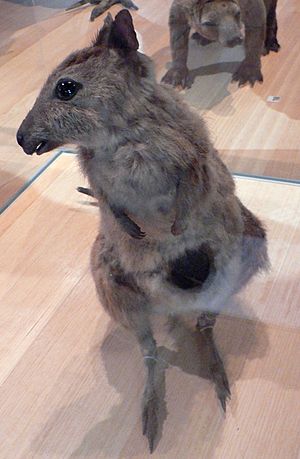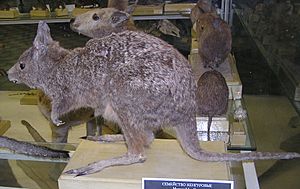Eastern hare-wallaby facts for kids
Quick facts for kids Eastern hare-wallaby |
|
|---|---|
 |
|
| Specimen at the Melbourne Museum | |
| Conservation status | |
| Scientific classification | |
| Genus: |
Lagorchestes
|
| Species: |
leporides
|
 |
|
| Historic eastern hare-wallaby range in orange | |
The eastern hare-wallaby (Lagorchestes leporides) was a type of wallaby that used to live in southeastern Australia. It is now an extinct species, meaning it no longer exists anywhere in the world. People sometimes called it the common hare wallaby. The first time scientists described this animal was in 1841, by a person named John Gould.
Contents
What did the Eastern Hare-Wallaby Look Like?

The eastern hare-wallaby was a small animal. It was a type of macropod, which is a group of animals that includes kangaroos and wallabies. It was a bit bigger and thinner than its living relative, the rufous hare-wallaby.
This wallaby's body was about 50 centimeters (20 inches) long. Its tail added another 33 centimeters (13 inches) to its length. Its fur could be black, brown, or yellow. Its belly was a grayish-white color.
Where Did They Live?
The eastern hare-wallaby once lived in several parts of Australia. These areas included the middle parts of New South Wales and Victoria. They also lived near the Murray River in South Australia.
They were quite common in the flat lands between the Murray and Darling rivers. You could also find them in a place called the Liverpool Plains. These wallabies liked to live in open plains and grasslands.
How Did They Live?
Scientists do not know much about the eastern hare-wallaby's daily life. We do know that it was a nocturnal animal. This means it was active at night. During the day, it lived alone and rested quietly. It would sit in a special spot it made, often hidden by a saltbush or a clump of tussock.
If someone got too close, it would quickly bound away. One time, a wallaby was chased by dogs for 500 meters (about 1,640 feet). It suddenly turned around and came very close to John Gould. It even jumped right over his head! These wallabies could jump as high as 1.8 meters (6 feet).
Why Did They Disappear?
The last eastern hare-wallaby that scientists know about was a female. It was found in August 1889 in New South Wales. After that, no one ever saw this species again. Even in the 1930s, some researchers were still not sure if it was truly extinct.
The exact reason for its extinction is still a bit of a mystery. It disappeared before large-scale farming became common in its habitat. It also died out before the red fox, an animal brought to Australia, became widespread.
However, scientists have some ideas about why it disappeared. These ideas include:
- Cattle and sheep walking all over their grassland homes.
- Changes in how people used to burn the land.
- Being hunted by cats, which were also brought to Australia by humans.
See also
 In Spanish: Ualabí oriental para niños
In Spanish: Ualabí oriental para niños



